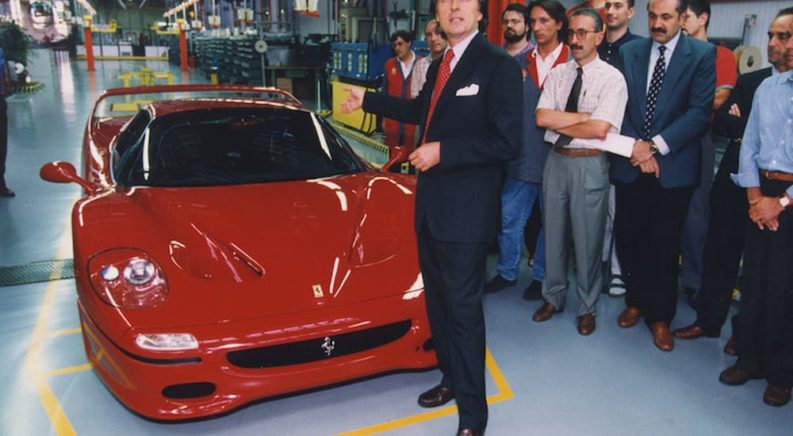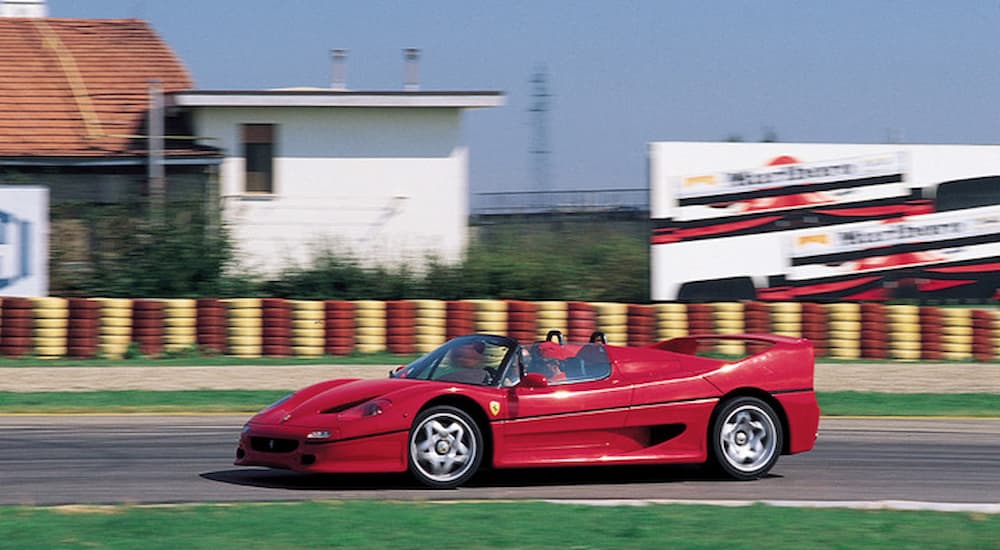Last month, I wrote about a car that was being sold at auction on November 5th, 2022: a 2003 Enzo Ferrari. The car is one of the most special members of a now-dissolved club called the Gran Turismo Collection by RM Sotheby’s. This is a relatively small collection composed of 18 of the rarest and most significant sports cars of the last 50 years, many or all of which were sold and went their separate ways. That is unless they all got scooped up by the same buyer, which, if the Sultan of Brunei was involved, they might have been.
The collection is inspiring not just for the models represented but for the stories of the lives led by many of the cars. The Enzo, with its high mileage, is a rare and special case of a single-owner example that has seen regular use for years and still returned $2 million. Today I turn the magnifying glass to its predecessor and stablemate of 16 years, the Ferrari F50, serial number 350+.
The Essence of F50
It seems insane that the F50 was ever undervalued or unappreciated, but upon reflection, perhaps it makes sense. It arrived two years before the 50th anniversary that it was intended to celebrate, at the tail end of an economic downswing caused by the Japanese bubble burst. It was the first Ferrari supercar produced without Enzo Ferrari’s input. The F50’s distinct styling was a controversial deviation from the norm of the day, and ultimately its performance merely matched the F40’s while being overshadowed by the titanic speed of the McLaren F1.
Focusing purely on aesthetics and performance, however, does a disservice to the F50’s designers. For Ferrari, the F50 was not about achieving new heights; it was about achieving the same heights in a new way. It was designed specifically to deliver an experience as close to Formula One as a road car could provide, and there can be no doubt that on this count, it delivered.
A Design On A Mission
Formula One technology and design philosophy permute the car from front to rear. The controversial (not to say bemoaned) styling is a function-first airflow control feature, from flaring nostrils to the enormous rear wing. Technological elements like inboard suspension with ECU-controlled damping came straight from F1 and continue to see popular use in high-performance vehicles today. Ferrari’s first carbon tub road car had a naturally aspirated F1-derived V12 engine bolted directly to its rear, with the transmission and rear suspension also mated directly to the engine. As a result, it functions as a load-bearing component of the chassis just as it did in the Formula One car.
The most basic AC system––you get a fan speed, a temperature dial, and that’s it––and wallet-sized pockets in the doors are the extent of the luxuries inside. There’s no power steering to assist you while driving and nothing on the 3-spoke steering wheel to distract from the job at hand. With no rubber bushings anywhere, the car is as stiff as can be––too stiff, really, for a road car, but that’s the point––and everything the engine has to say, it communicates directly to the driver. Every rattle, shake, and vibration is transmitted straight through the wall and the composite seat to the driver’s spine, mere inches away. The F50 was also the first Ferrari supercar without a fixed roof; if the interior isn’t loud enough as it is (Car and Driver measured a peak of 104 decibels), then off with the Targa top and in with the unabated chorus of explosive song.
It’s the only naturally aspirated, V12, fully manual powertrain to come from Maranello. It was not an obvious truth in 1995, and it probably wasn’t clear when the Enzo was released in 2003, but it’s plain as day now that there will never be anything like it again.
A Funny Taste
However, the early legacy of the F50 is shockingly lackluster. A perfect storm of developments in the economy and automotive industry leading up to 1995 conspired to dampen enthusiasm for the new supercar (outside of the original 349 buyers, of course). How was it that this car, which may end up as one of the most valuable of the entire Gran Turismo collection, could have once been so unappreciated as to have been considered a failure?
There was bound to be some tension surrounding the F50. It was hard to call Ferrari’s supercars a tradition at this point in time (there was only the 288 GTO and F40 before it), so there may have been a sense of disbelief as if Ferrari was out of touch and tres bourgeoisie by releasing this car in the wake of a serious economic downturn.
It was also the first Ferrari supercar produced without the guiding hand of Enzo himself, who passed away in 1988. Some may have viewed the elaborate styling as an unfortunate result of his absence. The fact that the F50 ultimately did little to improve on the performance metrics of the F40 may also have been attributed to Enzo-less leadership; maybe there was skepticism that new Ferraris wouldn’t be as timeless now that his direct influence was gone.
That’s all speculation on my part, but there’s no doubt that Ferrari’s decisions to combat financial speculation raised question marks in the industry. See, after caving to pressure to build more examples of the F40, Ferrari had to watch cynical buyers capitalize on the incredible demand by flipping their new Maranello specials for 7-figure paydays (hardly representative of the driving-focused spirit of the company). To prevent this from happening to the F50, Ferrari implemented two highly unusual and controversial measures: an application-to-buy survey (whereby they screened people against undisclosed criteria and deliberately chose buyers who matched their values) and a lease-only purchase program.
That’s right: Ferrari refused to actually sell the F50 outright. One of the only examples which was privately owned before 1997 was Serial Number 003, delivered to Andy Evans as thanks for his incredible performance as an IMSA team owner and driver of Ferrari race cars. Coincidentally, that example was the only way Car and Driver were able to track test the F50 because Ferrari wouldn’t allow it for leased vehicles!
Then there was the performance itself. Against the F40, it’s a little quicker to 60 mph, but the ¼-mile time at 12.1 s is basically the same, and the F40 is quicker to 170 mph. The F50 tops out at 202 mph, but the F40 was at 201 mph and didn’t have to live in the shadow of the generational icon that is the McLaren F1. In testing, the F50 fell short of the 200 mph mark and failed to surpass the F40’s 1.05 g road-holding (though Ferrari claimed a 1.2 g limit).
None of this makes the F50 a bad car or a bad deal, but it perhaps explains why many enthusiasts in the 1990s would have overlooked the F50’s most endearing traits. They saw a snobbishly exclusive path to ownership for an unobtainable car that looked strange and didn’t seem any more interesting than its predecessor. It didn’t even have a racing program to bolster its fandom – the F50 GT was canceled before it ever raced, and the three surviving examples are barred from participating in racing by Ferrari themselves. There was no way to know then just how special a fully manual F1-derived naturally aspirated V12 engine would be.
Chassis #107575
People do not think of the F50 this way anymore. And not everyone was so cynical – HRH Prince Jefri, brother to the Sultan of Brunei (one of the world’s most renowned car collectors), commissioned 3 of them outside of the official production run. Whether this means it lacks a special plaque denoting its serial number in the run of 349 is a mystery (for now), but thank goodness it was commissioned as a straight-up F50. Given who ordered it, there’d be little surprise if it’d been converted to a station wagon!
It is not clear if royal hands ever touched the wheel, but in 1997, it was delivered to Pininfarina for conversion to right-hand drive (as is the norm in Brunei) but then sold to a buyer in the UK who promptly mothballed it. It was some divine mercy that freed #107575 from its atrophied destiny in 2006 – it had a total of 700 km on the odometer, equivalent to only 50 miles a year. It’s almost criminal! A car is a machine, and machines are meant to move, but more F50s than not have suffered a similar fate, to the extent that their lethargy has caused as much damage as overuse might.
If you’re going to spend $75,000 in maintenance, either way, you might as well experience the car in the process; the now-former owner did just that! This liberated, potentially unserialized F50 got to work, and its odometer now sits at over 20,000 km, a hefty 800-or-so miles per year since its acquisition. That’s a healthy fistful of weekend jaunts with a track day sprinkled in here or there and probably about as much F50 as any non-Formula One driver can tolerate in a given year.
A 2019 overhaul worth nearly half my mortgage was completed along with prestigious Ferrari Classiche certification to ice the cake that was #107575’s time in the Gran Turismo collection. That’s no small thing because Ferrari keeps immaculate records of every car they build; the certification means that #107575 meets its exact factory specifications as-built and that its parts are authentic in every detail. It also means the owner is part of an exclusive club, invited to otherwise inaccessible celebrations and special opportunities to wring out the glorious V12 engine. Whether the Targa top is affixed to the chassis (as it was sold) or stored in its “circus box,” I’m sure both car and driver will be happy.
Forget Me Not F50
The Ferrari F50 suffered from much prejudice in its early days. Poor economic conditions, an alienating campaign to limit speculation, divergent styling devoid of Enzo’s blessed touch, a canceled racing program, and performance statistics no different than its predecessor all conspired to dampen the market for this incredibly rare supercar throughout the days of its relevance. Owners, such as whoever held Chassis #107575, tucked it away, terrified to drive it lest they damage its fragile value as they awaited the turnaround.
Around the same time that people probably came to realize that there wouldn’t be many N/A V12 powertrains left in our future, nevermind with a fully manual transmission and such authentic Formula 1 pedigree, #107575 fell into the open arms of the Gran Turismo collection. It’s stretched its legs in the years since and remains every bit as fresh as it was 25 years ago. Now that everybody recognizes just how special this car truly is, I dare expect it to stay that way.





